Achieving Peak Performance
Key Issues
Most organisations now accept that continuous change
and transformation have become the norm in a global
economy, while the pressure to deliver in this environment
is having a major impact on business performance in
addition to impairing the health of employees. Many
organisations realize they have both a desire and
responsibility to act.
The issue is that there have been few interventions that can be objectively measured to make a positive impact, and even fewer that can be sustained over time. In short, companies have struggled to find a solution to what has become a major obstacle to business performance in the 21st century.
Numerous scientific studies have now shown that excessive
pressure directly impacts the internal physiological
processes of individuals. This impact upon the internal
processes undermines performance, reduces perceptual
clarity and directly impairs personal performance.
Conversely, studies have demonstrated that peak performance
can be achieved and sustained, and the underlying
mechanisms are now well understood.
Evidence of Impact
The HeartMath program goes beyond the theory of behavior
management and has been shown to deliver measurable
improvements globally in business performance, personal
performance, staff turnover, health, customer satisfaction,
and organisational effectiveness. The major differentiator
of our programs is that their impact can be measured
and improvements sustained long-term. The data outlined
here have been generated through projects at Shell,
BP, Unilever, Cisco, Boeing and others working closely
with their business, health and organisational development
staff.
Subjective Data
Table 1: Improvements in Well-being before,
six weeks and six months after training.
(Percentage of individuals responding to the top
two of five possible answers)
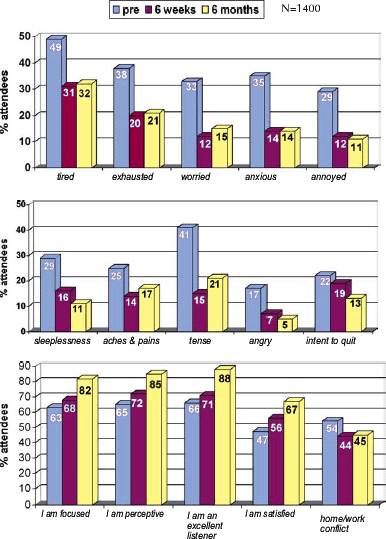
Objective Data
a.) Blood Pressure. High blood pressure affects one
in four adults in North America and Western Europe
and is considered one of the most important public
health issues facing the industrialized world. The
HeartMath program has been shown consistently to reduce
blood pressure. The size of this effect has been measured
at double the improvement that an exercise program
normally delivers and, if it were repeated across
the entire population, it could reduce the incidence
of stroke by approximately 50%.
Figure 1: Blood pressure data before and 3 months after training (sample size 78)

b.) Heart Rate Variability (HRV). HRV is a very sophisticated measure of overall health and wellbeing. It has repeatedly been shown to be a powerful predictor of all-cause mortality and underpins human performance and vitality. The scientific literature suggests that HRV should remain relatively stable over time, with 3-5% deterioration per annum. The significant improvements in HRV following the HeartMath program in those who used the tools represents not only a reduction in health risk but also a significant improvement in energy and vitality.
Figure 2: Percentage change in HRV measures eight weeks after the HeartMath program among a group of 59 executives.
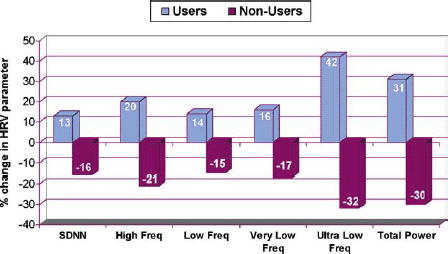
HeartMath has also been published, in peer-reviewed
scientific journals, on how training in the HeartMath
improves hormonal and immune function.
Impact on Cognitive Performance
Good decision-making, strategic thinking, innovation
and communication effectiveness are all underpinned
by specific cognitive processes. We continue to research
the impact of this training on cognitive performance.
For example, the non-profit Institute of HeartMath,
recently published data demonstrating a one to two
year improvement in reading and math performance in
school children taking state exams after just three
weeks of practicing the HeartMath techniques. We have
also demonstrated a significant improvement in reaction
times in individuals trained in HeartMath compared
to controls (Figure 3), a fact that may have relevance
to safety performance.
Figure 3: Improved Reaction Time before and after training based on auditory discrimination task. (sample size 30).
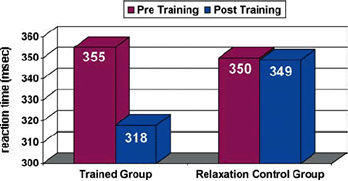
In a new study with one of the world's largest FMCG
companies, we demonstrated a significant improvement
in accuracy during a discrimination task and significantly
improved spatial working memory under increasingly
difficult demands. (Figure 4).
Figure 4: Improved Spatial Working Memory before
and after training (sample size 25)
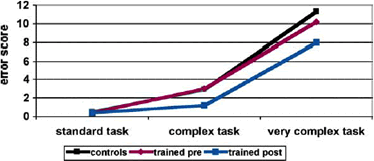
Advances in Safety Performance
Figure 5: Data gathered from eight separate North
Sea oil platforms, from individuals trained in the
HeartMath program, shows a significant reduction in
the number of "stressed" individuals, i.e.
those with GHQ scores over 3 (measured using the General
Hospital Questionnaire. >3 indicates the individual
is suffering from stress). The data also showed a
linear relationship between GHQ scores and safety,
measured using Total Recordable Case Frequency (TRCF.)
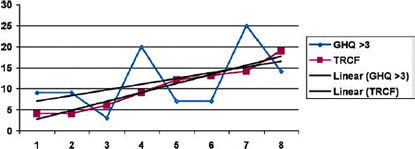
Summary
Working in close collaboration with the scientific
and business professionals within our client companies,
we have addressed the limitations of conventional
behavioral training. Our program provides practical
tools to facilitate exceptional performance, enabling
demonstrable benefit to be measured simultaneously
in health, well being, cognitive, safety and business
performance. Our programs can be run as a stand-alone
or integrated into a company's ongoing training process
and strategic initiatives. As organisations now have
to operate in an even more complex and demanding environment,
innovative solutions are now available to enable individuals
and teams to perform at a much higher level, while
maintaining a balanced lifestyle.
For Information
Telephone: (02) 9412 2500 (Australia)
Telephone: +61 2 9412 2500 (International)
E-Mail: info@macquarieinstitute.com.au
![]() Download our PDF
Brochure
Download our PDF
Brochure